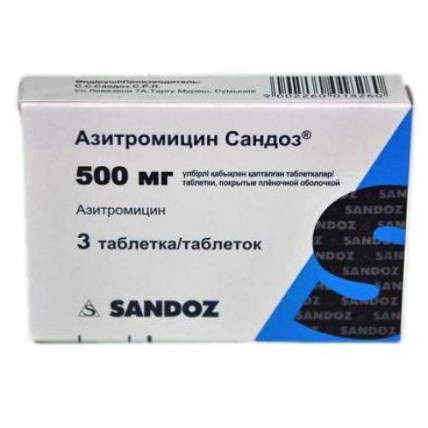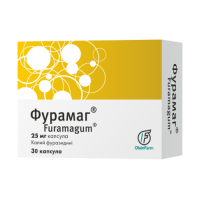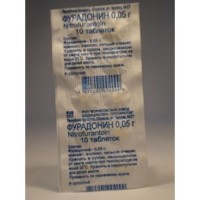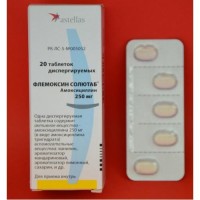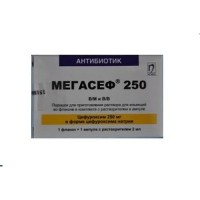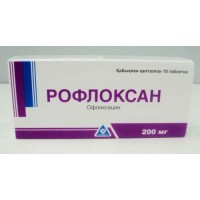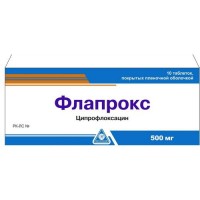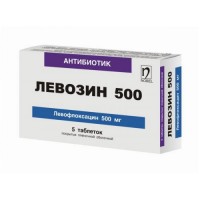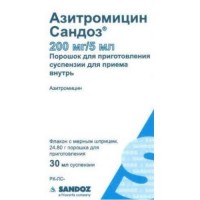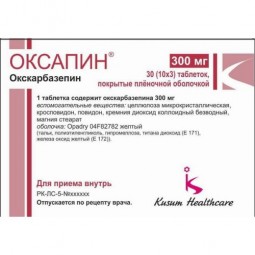Azithromycin Sandoz® 3's 500 mg film-coated tablets
- $28.90
The instruction for medical use
of medicine
Sandoz® Azithromycin
the Trade name
Sandoz® Azithromycin
the International unlicensed
name Azithromycin Dosage Form
of the Tablet, film coated 250 mg, 500 mg
Structure
One tablet contains
active substance - azithromycin monohydrate - 256.00 mg or 512.00 mg
excipients: microcrystalline cellulose, starch prezhelatinizirovanny, sodium glikolit starch, silicon anhydrous colloidal, sodium a lauryl sulfate, magnesium stearate
a cover:
opadriya, structure (polyvinyl alcohol, the titan dioxide, talc), soy lecithin, xanthane pitch
the Description
mg Сандоз® 250 Azithromycin – a tablet of the extended form, white or almost white color, film coated, flat on both sides.
Mg Сандоз® 500 azithromycin - a tablet of the extended form, white or almost white color, film coated, with the deep line for a break on one party, with risky on other party.
Pharmacotherapeutic group
Antibacterial drugs for system use. Macroleads.
ATC J01FA10 code
the Pharmacological
Pharmacokinetics Absorption Later properties of intake bioavailability of azithromycin makes 37%. Azithromycin is quickly absorbed from the digestive tract (DT) that is caused by its stability in acidic environment and lipophilicity. After intake of azithromycin inside in a dose of 500 mg of Cmax of azithromycin in blood plasma it is reached in 2-3 h and makes 0.4 mg/l.
Distribution
Azithromycin well gets into airways, bodies and fabrics of an urogenital highway (in particular in a prostate), in skin and soft tissues. High concentration in fabrics (is 10-50 times higher, than in blood plasma) and long T1/2 are caused by low linking of azithromycin with proteins of blood plasma and also its ability to get into eukaryotic cells and to concentrate in the environment with low pH surrounding lysosomes. It, in turn, defines big Vd and high plasma clearance. The ability of azithromycin to collect mainly in lysosomes is especially important for elimination of intracellular activators. It is proved that phagocytes deliver azithromycin to places of localization of an infection where it is released in the course of phagocytosis. Concentration of azithromycin in the centers of an infection it is reliable above, than in healthy fabrics (on average for 24-34%) and correlates with the degree of manifestation of inflammatory hypostasis. Despite high concentration in phagocytes, azithromycin has no significant effect on their function.
Azithromycin remains in bactericidal concentration in the inflammation center within 5-7 days after reception of the last dose that allowedshort (3-day and 5-day) courses of treatment.
Removal
Plasma elimination half-life is close to elimination half-life from fabrics – 2-4 days. About 12% of the dose entered azithromycin intravenously are removed with urine in an invariable look within 3 days. The majority is removed the first 24 hours. Biliary removal mainly in an invariable form, is the main way of removal. The identified metabolites are inactive.
Pharmacodynamics
Antibiotic of a broad spectrum of activity. Is the representative of subgroup of makrolidny antibiotics - azaleads. The principle of action is based on inhibition of synthesis of proteins in a bacterium by linking with 50 ribosome subunits and prevention of a translocation of peptides. Usual effect of azithromycin bacteriostatic, but during creation in the center of inflammation of high concentrations has bactericidal effect.
Gram-positive cocci are sensitive to azithromycin: Streptococcus pneumoniae, St. pyogenes, streptococci of the groups CF and G, Staphylococcus aureus, St. viridans, gram-negative bacteria: Haemophilus influenzae, Moraxella catarrhalis. Bordetella pertussis. H.ducrer, Neisseria gonorrhoeae and Gardnerella vaginalis, some anaerobic microorganisms: Bacteroides bivius, Clostridium perfringens and also Chlamydia trachomatis, Mycoplasma pneumoniae, Ureaplasma urealyticum. Treponema pallidum, Borrelia burgdoferi.
Cross stability of organisms of the Mycobacterium avium complex between klaritromitsiny and azithromycin was observed. Azithromycin is inactive concerning the gram-positive bacteria resistant to erythromycin.
Indications
- a tonsillitis, sinusitis, tonsillitis, average otitis
- bacterial pneumonia (including atypical), bronchitis
- scarlet fever
- the ugly face, impetigo which are again infected a dermatosis
- the uncomplicated urethritis and/or a cervicitis caused by Chlamydia trachomatis
- a disease Laima (borreliosis) - for treatment of an initial stage (erythema migrans)
- the diseases of a stomach and a duodenum associated with Helicobacter pylori
the Route of administration and doses
Inside for 1 h to or in 2 h after a meal of 1 times a day.
The adult
In an uncomplicated urethritis and/or a cervicitis, the caused Chlamydia trachomatis once - 1000 mg,
In infections of upper and lower parts of airways - 500 mg/days for 1 reception within 3 days (a course dose - 1.5 g).
In infections of skin and soft tissues - 1000 mg/days in the first day for 1 reception, further on 500 mg of days daily from 2 to 5 day (a course dose - 3 g).
In a disease Laima (borreliosis) for treatment of the I stage (erythema migrans) - 1 g in the first day, 500 mg daily from 2 to 5 day (a course dose - 3 g).
In a peptic ulcer - a stomach and a duodenum associated with Helicobacter pylori - 1 g/days within 3 days as a part of the combined antikhelikobakterny therapy.
To elderly patients
the Mode of dosing same as well as at adult patients.
Children
of the Tablet Sandoz® Azithromycin should appoint to children with body weight more than 45 kg. At body weight less than 45 kg other dosage forms of azithromycin in the form of suspension are used.
Side effects
Very often
- nausea, vomiting, diarrhea
Often
- dizziness, a headache, insomnia
- spasms
- disturbance of perception of taste and a smell
- a meteorism, a digestive disturbance, loss of appetite
- rash, an itching
- a joint pain
Seldom
- weakness, fatigue, an indisposition, a loss of consciousness
- candidiasis
- obstipation, psevdomembarnozny colitis, inflammation of a pancreas, hepatitis, jaundice, defeat of cells of a liver, a liver and renal failure
- coloring
- teeth and language
- change of level of liver enzymes in blood plasma, a leukopenia, an erythropenia
- decrease in hearing, a ring in ears
- paresthesia
- a tremor
- insomnia, hyperactivity, irritability, nervousness, a depression, delirium
- long healing of wounds, bruises, erubescence
- a photosensitization
- hypostasis of hypodermic cellulose
Very seldom
-
Contraindication arrhythmia
- heavy renal failures
- heavy abnormal liver functions
- pregnancy
- the period of a lactation (breastfeeding)
- children's age up to 12 months
- hypersensitivity to azithromycin and other antibiotics of group of macroleads
Medicinal interactions
- Antacids (aluminum and magniysoderzhashchy), ethanol and food slow down and reduce absorption. Therefore azithromycin should be accepted in 1 hour prior to or in 2 hours after a meal.
- At joint prescribing of warfarin and azithromycin (in usual doses) changes of a prothrombin time it is not revealed, however, considering that in interaction of macroleads and warfarin strengthening of anti-coagulative effect is possible, careful control of a prothrombin time is necessary for patients.
- Digoxin: increase in concentration of digoxin.
- Ergotamine and dihydroergotamine: strengthening of toxic action (ergotism, vasospasm, dizesteziya).
- To triazoles, astemizol, midazolam, alfentanit: it is necessary to be careful at joint appointment with azithromycin, in view of possible increase in activity of the last.
- Slows down removal and increases concentration in plasma and toxicity of Cycloserinum, indirect anticoagulants, Methylprednisolonum, a felodipin and also the HP which are exposed to microsomal oxidation (carbamazepine, terfenadin, cyclosporine, hexobarbital. ergot alkaloids, valproic acid, Disopyramidum, Bromocriptinum, Phenytoinum, oral hypoglycemic means, theophylline, etc. ksantinovy derivatives) - at the expense of inhibition of microsomal oxidation in hepatocytes azithromycin.
- Pharmaceutical it is incompatible with heparin.
Special instructions
It is necessary to observe a break in 2 h at simultaneous use of antacids. After cancellation of treatment of reaction of hypersensitivity at some patients can remain that demands specific therapy under observation of the doctor.
Considering features of influence of medicine on ability to run the vehicle or potentially dangerous mechanisms, possible side effects a type of dizziness and convulsions it is necessary to be careful.
Overdose
Symptoms
reversible hearing loss, profound nausea, vomiting and diarrhea.
Treatment
of gastric lavage and general maintenance therapy.
The form of release and packing
of the Tablet film coated are issued in the blister, PVH/PVDH of 250 microns consisting of a white opaque film / 60 and PVC/PVA copolymer, covered with an aluminum film of 20 microns on 6 and 3 tablets, in a cardboard pack (No. 3, 6) together with the instruction for use.
To Store storage conditions at a temperature not above +25 °C.
To store out of children's reach!
A period of storage
3 years
do not use drug after the expiry date specified on packing.
Prescription status
According to the prescription
Producer S.S. Sandoz S.R.
L. Livezeni St. 7A, Targu Muresh, Romania
of medicine
Sandoz® Azithromycin
the Trade name
Sandoz® Azithromycin
the International unlicensed
name Azithromycin Dosage Form
of the Tablet, film coated 250 mg, 500 mg
Structure
One tablet contains
active substance - azithromycin monohydrate - 256.00 mg or 512.00 mg
excipients: microcrystalline cellulose, starch prezhelatinizirovanny, sodium glikolit starch, silicon anhydrous colloidal, sodium a lauryl sulfate, magnesium stearate
a cover:
opadriya, structure (polyvinyl alcohol, the titan dioxide, talc), soy lecithin, xanthane pitch
the Description
mg Сандоз® 250 Azithromycin – a tablet of the extended form, white or almost white color, film coated, flat on both sides.
Mg Сандоз® 500 azithromycin - a tablet of the extended form, white or almost white color, film coated, with the deep line for a break on one party, with risky on other party.
Pharmacotherapeutic group
Antibacterial drugs for system use. Macroleads.
ATC J01FA10 code
the Pharmacological
Pharmacokinetics Absorption Later properties of intake bioavailability of azithromycin makes 37%. Azithromycin is quickly absorbed from the digestive tract (DT) that is caused by its stability in acidic environment and lipophilicity. After intake of azithromycin inside in a dose of 500 mg of Cmax of azithromycin in blood plasma it is reached in 2-3 h and makes 0.4 mg/l.
Distribution
Azithromycin well gets into airways, bodies and fabrics of an urogenital highway (in particular in a prostate), in skin and soft tissues. High concentration in fabrics (is 10-50 times higher, than in blood plasma) and long T1/2 are caused by low linking of azithromycin with proteins of blood plasma and also its ability to get into eukaryotic cells and to concentrate in the environment with low pH surrounding lysosomes. It, in turn, defines big Vd and high plasma clearance. The ability of azithromycin to collect mainly in lysosomes is especially important for elimination of intracellular activators. It is proved that phagocytes deliver azithromycin to places of localization of an infection where it is released in the course of phagocytosis. Concentration of azithromycin in the centers of an infection it is reliable above, than in healthy fabrics (on average for 24-34%) and correlates with the degree of manifestation of inflammatory hypostasis. Despite high concentration in phagocytes, azithromycin has no significant effect on their function.
Azithromycin remains in bactericidal concentration in the inflammation center within 5-7 days after reception of the last dose that allowedshort (3-day and 5-day) courses of treatment.
Removal
Plasma elimination half-life is close to elimination half-life from fabrics – 2-4 days. About 12% of the dose entered azithromycin intravenously are removed with urine in an invariable look within 3 days. The majority is removed the first 24 hours. Biliary removal mainly in an invariable form, is the main way of removal. The identified metabolites are inactive.
Pharmacodynamics
Antibiotic of a broad spectrum of activity. Is the representative of subgroup of makrolidny antibiotics - azaleads. The principle of action is based on inhibition of synthesis of proteins in a bacterium by linking with 50 ribosome subunits and prevention of a translocation of peptides. Usual effect of azithromycin bacteriostatic, but during creation in the center of inflammation of high concentrations has bactericidal effect.
Gram-positive cocci are sensitive to azithromycin: Streptococcus pneumoniae, St. pyogenes, streptococci of the groups CF and G, Staphylococcus aureus, St. viridans, gram-negative bacteria: Haemophilus influenzae, Moraxella catarrhalis. Bordetella pertussis. H.ducrer, Neisseria gonorrhoeae and Gardnerella vaginalis, some anaerobic microorganisms: Bacteroides bivius, Clostridium perfringens and also Chlamydia trachomatis, Mycoplasma pneumoniae, Ureaplasma urealyticum. Treponema pallidum, Borrelia burgdoferi.
Cross stability of organisms of the Mycobacterium avium complex between klaritromitsiny and azithromycin was observed. Azithromycin is inactive concerning the gram-positive bacteria resistant to erythromycin.
Indications
- a tonsillitis, sinusitis, tonsillitis, average otitis
- bacterial pneumonia (including atypical), bronchitis
- scarlet fever
- the ugly face, impetigo which are again infected a dermatosis
- the uncomplicated urethritis and/or a cervicitis caused by Chlamydia trachomatis
- a disease Laima (borreliosis) - for treatment of an initial stage (erythema migrans)
- the diseases of a stomach and a duodenum associated with Helicobacter pylori
the Route of administration and doses
Inside for 1 h to or in 2 h after a meal of 1 times a day.
The adult
In an uncomplicated urethritis and/or a cervicitis, the caused Chlamydia trachomatis once - 1000 mg,
In infections of upper and lower parts of airways - 500 mg/days for 1 reception within 3 days (a course dose - 1.5 g).
In infections of skin and soft tissues - 1000 mg/days in the first day for 1 reception, further on 500 mg of days daily from 2 to 5 day (a course dose - 3 g).
In a disease Laima (borreliosis) for treatment of the I stage (erythema migrans) - 1 g in the first day, 500 mg daily from 2 to 5 day (a course dose - 3 g).
In a peptic ulcer - a stomach and a duodenum associated with Helicobacter pylori - 1 g/days within 3 days as a part of the combined antikhelikobakterny therapy.
To elderly patients
the Mode of dosing same as well as at adult patients.
Children
of the Tablet Sandoz® Azithromycin should appoint to children with body weight more than 45 kg. At body weight less than 45 kg other dosage forms of azithromycin in the form of suspension are used.
Side effects
Very often
- nausea, vomiting, diarrhea
Often
- dizziness, a headache, insomnia
- spasms
- disturbance of perception of taste and a smell
- a meteorism, a digestive disturbance, loss of appetite
- rash, an itching
- a joint pain
Seldom
- weakness, fatigue, an indisposition, a loss of consciousness
- candidiasis
- obstipation, psevdomembarnozny colitis, inflammation of a pancreas, hepatitis, jaundice, defeat of cells of a liver, a liver and renal failure
- coloring
- teeth and language
- change of level of liver enzymes in blood plasma, a leukopenia, an erythropenia
- decrease in hearing, a ring in ears
- paresthesia
- a tremor
- insomnia, hyperactivity, irritability, nervousness, a depression, delirium
- long healing of wounds, bruises, erubescence
- a photosensitization
- hypostasis of hypodermic cellulose
Very seldom
-
Contraindication arrhythmia
- heavy renal failures
- heavy abnormal liver functions
- pregnancy
- the period of a lactation (breastfeeding)
- children's age up to 12 months
- hypersensitivity to azithromycin and other antibiotics of group of macroleads
Medicinal interactions
- Antacids (aluminum and magniysoderzhashchy), ethanol and food slow down and reduce absorption. Therefore azithromycin should be accepted in 1 hour prior to or in 2 hours after a meal.
- At joint prescribing of warfarin and azithromycin (in usual doses) changes of a prothrombin time it is not revealed, however, considering that in interaction of macroleads and warfarin strengthening of anti-coagulative effect is possible, careful control of a prothrombin time is necessary for patients.
- Digoxin: increase in concentration of digoxin.
- Ergotamine and dihydroergotamine: strengthening of toxic action (ergotism, vasospasm, dizesteziya).
- To triazoles, astemizol, midazolam, alfentanit: it is necessary to be careful at joint appointment with azithromycin, in view of possible increase in activity of the last.
- Slows down removal and increases concentration in plasma and toxicity of Cycloserinum, indirect anticoagulants, Methylprednisolonum, a felodipin and also the HP which are exposed to microsomal oxidation (carbamazepine, terfenadin, cyclosporine, hexobarbital. ergot alkaloids, valproic acid, Disopyramidum, Bromocriptinum, Phenytoinum, oral hypoglycemic means, theophylline, etc. ksantinovy derivatives) - at the expense of inhibition of microsomal oxidation in hepatocytes azithromycin.
- Pharmaceutical it is incompatible with heparin.
Special instructions
It is necessary to observe a break in 2 h at simultaneous use of antacids. After cancellation of treatment of reaction of hypersensitivity at some patients can remain that demands specific therapy under observation of the doctor.
Considering features of influence of medicine on ability to run the vehicle or potentially dangerous mechanisms, possible side effects a type of dizziness and convulsions it is necessary to be careful.
Overdose
Symptoms
reversible hearing loss, profound nausea, vomiting and diarrhea.
Treatment
of gastric lavage and general maintenance therapy.
The form of release and packing
of the Tablet film coated are issued in the blister, PVH/PVDH of 250 microns consisting of a white opaque film / 60 and PVC/PVA copolymer, covered with an aluminum film of 20 microns on 6 and 3 tablets, in a cardboard pack (No. 3, 6) together with the instruction for use.
To Store storage conditions at a temperature not above +25 °C.
To store out of children's reach!
A period of storage
3 years
do not use drug after the expiry date specified on packing.
Prescription status
According to the prescription
Producer S.S. Sandoz S.R.
L. Livezeni St. 7A, Targu Muresh, Romania
